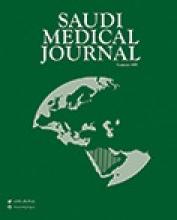Abstract
OBJECTIVE: To generate consensus gene expression profiles of invasive breast tumors from a small cohort of Saudi females, and to explore the possibility that they may be broadly conserved between Caucasian and Middle Eastern populations.
METHODS: This study was performed at King Faisal Specialist Hospital and Research Centre, Riyadh, Kingdom of Saudi Arabia, from January 2005 to January 2007. Gene expression profiles were generated from 38 invasive breast tumors, and 8 tumor adjacent tissues TATs using BD Atlas cDNA expression arrays containing 1176 genes. Results were confirmed by reverse transcriptase polymerase chain reaction, and analyzed by 2-dimensional unsupervised hierarchical clustering.
RESULTS: The analysis identified 48 differentially expressed genes in tumors from which 25 are already reported by various western studies. Forty-three of these genes were also differentially expressed in TATs. The same data set has been able to distinguish between tumors and the TATs, interestingly by using only 4 of the differentially expressed genes. Moreover, we were able to group the patients according to prognosis to an extent by hierarchical clustering.
CONCLUSION: Our results indicate that expression profiles between Saudi females with breast cancer and the Caucasian population are conserved to some extent, and can be used to classify patients according to prognostic groups. We also suggest 3 differentially-expressed genes IGHG3, CDK6, and RPS9 in tumors may have a novel role in breast cancer. In addition, the role of TATs is much more essential in breast cancer, and needs to be explored thoroughly.
- Copyright: © Saudi Medical Journal
This is an open-access article distributed under the terms of the Creative Commons Attribution-Noncommercial-Share Alike 3.0 Unported, which permits unrestricted use, distribution, and reproduction in any medium, provided the original work is properly cited.






